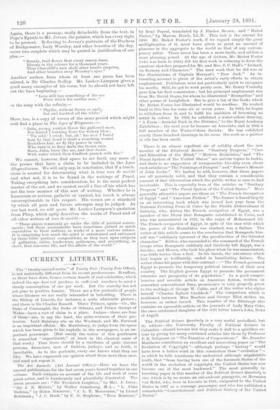The Art Annuals. (Art Journal Office.)—Here we have the annual
publications for the last seven years bound together in one volume. Each contains an account of the life and work of some great artist, and is handsomely and plentifully illustrated. The seven annuals are "Sir Frederick Leighton," by Mrs. A. Lang ; "Sir J. E. Millais," by Walter Armstrong, M.A.; "L. Alma Tadema," by Helen Zimraern ; "J. L. E. Meissonier," by Lionel Robinson ; "J. C. Hook," by F. G. Stephens; "Rosa Bonheur,"
by Ron6 Peyrol, translated by J. Finden Brown ; and "Birket Foster," by Marcus Huish, LL.B. This last is the annual for 1890. Mr. Birket Foster's work, if we regard simply the great multiplication of it, must have given as great an amount of Pleasure in the aggregate to the world as that of any contem- porary artist. There never has been a more facile, and seldom a more pleasing, pencil. At the age of sixteen, Mr. Birket Foster (who was born in 1825) did his first work in reducing to form the amateur sketches prepared for Mr. and Mrs. S. C. Hall's "Ireland, its Scenery and Character." The next work that he did was on the illustrations of Captain Marryat's "Poor Jack." An in- teresting account is given of the artist's early efforts to obtain employment. Publishers were not particularly quick to recognise his merits. Still, he got to work pretty soon. Mr. Henry Vizetelly gave him his first commission ; but his principal employment was from Mr. David Bogue, for whom ho illustrated "Evangeline" and other poems of Longfellow. But to give a list of the books which Mr. Birket Foster has illustrated would be needless. He worked hard in this lino for some six or seven years. In 1858, he began to withdraw from it, and to fulfil his ambition of becoming an artist in colour. In 1859, he exhibited a water-colour drawing, "A Farm—Arundel Park in the Distance," to the Royal Academy Exhibition ; the next year he became an Associate, and in 1862 a full member of the Water-Colour Society. He has exhibited nearly three hundred drawings in its room. His work as a painter in oils has been small.
There is an almost repellent air of solidity about the new number of the Edinburgh Review. "Sanitary Progress," "Care and Education of the Blind," "Modern &Comics," and "The Fiscal System of the United States" are serious topics to tackle, and there is no suggestion of irresponsible frivolity even about such articles as "The Paintings of Pompeii" and " Fraser's Memoir of John Locke." We hasten to add, however, that those papers are all genuinely solid, and that they contain a considerable amount of that information which the public writer is sure to find invaluable. This is especially true of the articles on "Sanitary Progress" and "The Fiscal System of the United States." More generally attractive papers are those on "The French Occupation of Egypt" and "American Fiction." The former is based largely on an interesting book which was issued last year from the National Printing Press of Cairo by the Sheikh Abderrahman el Gabarty, who, during the French occupation of Egypt, was a member of the Divan that Bonaparte established in Cairo, and who was assassinated in 1822, in the reign of Mohammed Ali. The French occupation of Egypt, in spite of the ease with which the power of the Mamelukes was crushed, was a failure. The writer of this article comes to the conclusion that Bonaparte him- self was "sublimely ignorant of the peculiarities of the Oriental character." Kleber, who succeeded to the command of the French troops when Bonaparte suddenly and furtively left Egypt, was a fanatic ; and Memo, who took his place when he was assassinated, was little better than a fool. In his hands, the adventure which had begun so brilliantly, ended in humiliating failure. The writer closes his paper with this contrast :—" The French governed Egypt to promote the temporary political interests of their own country. The English govern Egypt to promote the permanent interests and prosperity of its population." In a good compre- hensive and sensible article on American fiction, written on somewhat conventional lines, prominence is very properly given to the writings of George W. Cable, and of the writer who styles herself "Charles Egbert Craddock." The comparison whioh is instituted between Miss Murfree and George Eliot strikes us, however, as rather forced. This number of the Edinburgh also contains an agreeable article on the journals of Lady Mary Coke, the once celebrated daughter of the still better known John, Duke of Argyll.






































 Previous page
Previous page